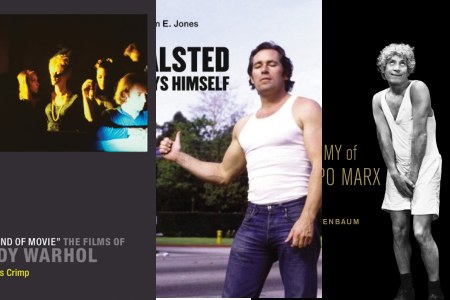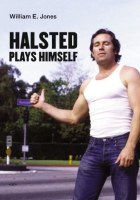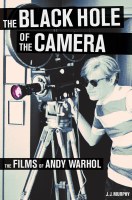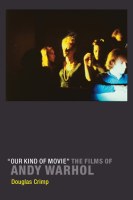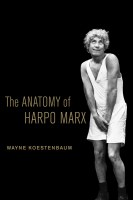The major LGBT film festivals tout their maturity this year (LA’s Outfest is 30 and San Francisco’s Frameline is four years shy of 40), and it stands to reason that they would also be celebrating the rich history of writing on film from queer perspectives. First and foremost, the work of pioneering LGBT film activist Vito Russo, the subject of Jeffrey Schwartz’s high-profile documentary Vito, which is playing both festivals. But they’re also featuring contemporary voices: B. Ruby Rich, author of Chick Flicks: Theories and Memories of the Feminist Film Movement, and an upcoming book, The Rise and Fall of New Queer Cinema, gets the Frameline Award, and John Waters, who has an increasingly literary practice with books like Role Models, receives an Outfest Achievement Award. (We’ll have to wait another round for a celebration of Derek Jarman’s literary output.) What follows are a list of four formidable recent titles that address various queer and queer-friendly reads on experimental and mainstream cinema.
1. Halsted Plays Himself (William E. Jones, The MIT Press)
Gay porn, and its ability to encapsulate the psychosexual and cultural mores of a segment of American men, has been a generative arena for filmmaker, artist and scholar William E. Jones. In his films, he’s appropriated and reused scenes from vintage all-male XXX material (he worked as something of a producer/archivist in the industry) and for his 1997 Finished, used landscape to elucidate his fantasy of a Canadian porn star who, he learned in the course of research, had committed suicide. The notorious pornographer Fred Halsted seems like a similarly troubled character, but also one with cinematic chops and panache for choreographing and depicting rough sex—in an era when porn was still screened on celluloid in specialty cinemas. Halsted’s first film, the 1972 L.A. Plays Itself is a classic of the form, as much for its artistic ambitions as its boundary-pushing sexuality. (The film is also appreciated by film theorist Thom Andresen whose highly regarded 2003 film essay on place in movies, Los Angeles Plays Itself, nods to Halsted’s most famous title.)
Jones approaches this well-illustrated project with a compelling combination of detective work, obsessive fandom, and academic interest. He traces his path to uncovering the truth about Halsted’s elusive, self-constructed identity and entrepreneur, actor and filmmaker. The latter sections of the book Jones reprints reviews of the films in gay porn rags, as well as a Village Voice piece by Jonas Mekas, who likens Halsted to Jack Smith; interviews, articles, and Halsted’s erotic writing. It’s a fascinating, troubling portrait, and one that does much to add legitimacy to this unexpected auteur.
2. The Black Hole of the Camera: The Films of Andy Warhol (J.J. Murphy, University of California Press)
The sheer amount of critical writing relating to Andy Warhol’s work is stunning, and the amount of interesting material just keeps on coming, thanks in no small part to the restoration and increasing availability of his films. Film scholar J.J. Murphy’s addition to the Warhol bookshelf is a thorough survey of the artist’s work in cinema. It’s an engaging, invaluable volume that does much to reframe Warhol’s complex use of the medium. Murphy essentially disavows the standard read that the films, particularly the notorious early pieces like Empire and Sleep, were conceptual, formalist exercises that aren’t even necessary to see, and were artless in cinematic terms, that Warhol simply turned on the camera and let his superstars go. Rather, Murphy argues, the films are more often than not scripted, carefully composed, art directed, and edited in ways that haven’t quite been acknowledged. The concept of psychodrama, as a directorial approach, is at play here, as is the generally misunderstood authorship of Warhol’s films, many made with varying degrees of collaboration with folks like Ronald Tavel, Chuck Weins, and Paul Morrissey, whose work are given separate chapters. Murphy includes useful descriptive entries on each of the films, making this a terrific resource in this burgeoning field.
3. ‘Our Kind of Movie’: The Films of Andy Warhol (Douglas Crimp, The MIT Press)
In intellectual circles, Douglas Crimp is probably as iconic as Andy Warhol, whose films are the subject of his recent collection of essays. The title “Our Kind of Movie” comes from a quote from Warhol himself, a reference to the curious, definitely queer niche that his cinema has always occupied—a charged zone between underground, commercial, art, and porn. Crimp starts his exploration from a personal place, noting his own coming of age as a gay man in 1960s New York, where he saw a few of the films for the first time. The fact that these works are becoming more available, albeit still not with YouTube ease, has enabled Crimp to do closer reads of works such as the seminal Blow Job, that deceptively formal 1964 16mm project, which deals as much with sexuality as media awareness—a theme that runs through all the essays in the book. Mario Montez, the crossdressed star of numerous works, is cited as a powerful figure in discussing aspects of sexual mores, of comedic eroticism, and the key position shame holds in gay male culture (as does analysis of the 1965 film, My Hustler). Crimp strikes a wonderful balance of academic references (Eve Kosofsky Sedgwick is a strong presence) and more subjective narrative—an anecdote about Crimp convincing his mother to send him her Adrian dress, so he could pass it along to Holly Woodlawn, is a convincing personal connection to the material.
4. The Anatomy of Harpo Marx (Wayne Koestenbaum, University of California Press)
Wayne Koestenbaum, an inveterate thinker on the meaning of icons, weighed in on Warhol with a critical biography in 2001. His latest book is a Barthes-influenced, highly idiosyncratic homage to Harpo Marx, the silent, but hardly quiet member of the Marx Brothers. The form of this exhaustive book is a frame-by-frame read of scenes in all 13 of the Marx Brothers’ comedies, but the approach is anything but conventional. With a poetic sensibility, sensuous curiosity, and boundless intellect, Koestenbaum uses Harpo, a character who he came to know later in life, as a literary subject. “As Andy Warhol filmed a man sleeping and called it Sleep,” he writes, “I want to commit media-heist, to steal a man from his native silence and transplant him into words.” Koestenbaum’s use of language is, thankfully, visually lush, as well as incisive: “Batty bingo-eyes oscillate; tongue protrudes” or “Harpo’s limp hands flamboyantly advertise indifference to standard opinions about how men should behave.” This, however, is no attempt to plant biographical innuendo about Harpo’s sexuality. Koestenbaum fully discloses his own manipulation of the character; he uses him as an object to focus on and project his own idiosyncratic interests, not the least of which are erotics and Jewish identity: “The title’s ‘cocoanuts’ refers to the Marx Brothers, whose Jewish ‘nuts,’ their testicles, their masculinities, have a suspect, pigmented, tropical undertone; but the fruity title especially applies to Harpo, a sweet nothing with a hollow noggin that promises a forbidden medley of milk and meat.” Comprised of dense packets of prose, this is a volume best taken as a decadent dessert course.
[Also of note is Koestenbaum’s characteristically fantastical The Elizabeth Taylor Puzzle, included in the anthology of film writing, Life As We Show It (City Lights, 2009).]

